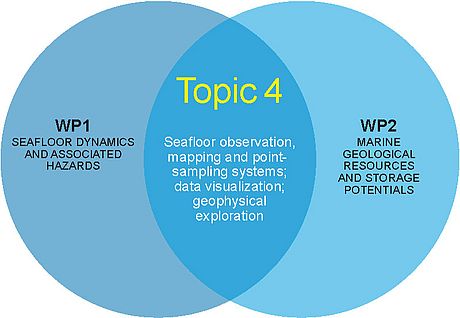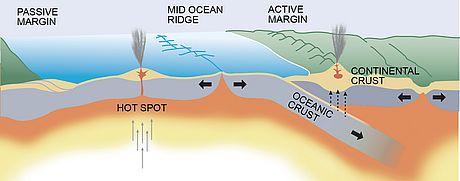Topic 4: Seafloor Dynamics, Hazards and Resources
Topic speaker: Prof. Dr. Colin Devey
(Deputy: Prof. Dr. Heidrun Kopp)
Mission:
To improve our understanding of how seafloor is created, modified and destroyed and how its resources and hazards are related to these processes through detailed observations, sampling, analytical studies and modelling.
Challenges
Plate tectonics continually creates, modifies and destroys seafloor. A huge range of magmatic and tectonic processes affects the plates during this cycle. Some of the processes (eruptions, earthquakes, mass wasting) pose threats to humankind while others (e.g. seafloor spreading, sedimentary basin evolution) generate valuable resources in and on the seafloor. Exploitation of these resources may support economic growth but could also have harmful consequences for marine ecosystems. This topic aims to advance our understanding of seafloor generation and evolution and how this relates to hazards and resources. We wish to improve hazard forecasting and risk - as well as resource - assessment. The major challenge is to make observations not only at the required spatial resolution but also over representative areas. This will require development and deployment of innovative technologies combined with multi-facetted modelling.
Current Activities and Previous Work
Over the last five years, GEOMAR has carried out a wide array of projects to investigate the dynamic nature of ocean basins and the natural hazards arising from them. The generation and destruction of the oceanic plates have been the subject of coordinated projects, such as the DFG priority programme SPP1144 “From Mantle to Ocean: Energy-, Material-, and Life-cycles at Spreading Axes" (2003-2009), the SFB574 “Fluids and Volatiles in Subduction Zones” (2000-2012) and the KALMAR German-Russian collaborative project. These projects focused on mid-ocean ridge and subduction zone dynamics. One of the focuses of Topic 4 scientists within the Excellence Cluster "Future Ocean" is the study of geohazards, primarily focusing on submarine slope failures. In addition, individual projects, generally in collaboration with international partners, have been carried out to constrain the geodynamic and magmatic processes accompanying continental break-up; to study the origin, evolution and environmental consequences of submarine large igneous provinces (together with colleagues from AWI); and to investigate intraplate volcanism, including hotspots, diffuse seamount provinces and isolated volcanic centres on the seafloor and on land. Participation in IODP Legs has provided the framework to study the controls of submarine slope stability, as well as the magmatic evolution and time series of explosive volcanism around the Pacific basin. GEOMAR is also involved in shoreline-crossing studies of plate margins and together with GFZ and other international partners have conducted large-scale onshore-offshore seismic experiments in the Atlantic, Indian and Pacific Oceans, and the Mediterranean and Caribbean Seas. These experiments have significantly increased understanding of margin processes. In addition, GEOMAR has installed the marine components of the German-Indonesian Tsunami Early Warning System along the Sunda Arc. For these studies, one of GEOMAR´s strengths at sea is to augment standard sampling and measurement techniques with cutting-edge methods, such as 3D and deep-tow seismic experiments, electromagnetic sources and receivers, and sampling and mapping using remote and autonomous deep-submergence vehicles. These techniques, combined with state-of-the-art shore-based analytical facilities and modelling expertise, have allowed GEOMAR to carry out world-class science. For example in quantifying and modelling the fluxes and atmospheric effects of climate-relevant magmatic volatiles, in the 3D-reconstruction of the deep-sea floor from video, and in investigating the relationship between volcanism and global change. GEOMAR scientists are currently refining and adapting techniques to measure distance on the seafloor by developing the emerging field of seafloor geodesy in order to investigate inter-seismic strain off the coast of Chile, the active margin responsible for some of the largest mega-thrust earthquakes in the last 100 years.
Using its comprehensive portfolio of sea-going instrumentation, GEOMAR has also studied marine geological resources in a variety of settings, in many cases in cooperation with GFZ. The migration of gases and fluids in sedimentary deposits and the seepage of methane from geological formations into the overlying seawater have been studied to understand the environmental effects of hydrocarbon seepage and the formation of near-seafloor gas hydrate deposits. In a complementary approach, GFZ has developed regional 3D structural models of the subsurface and simulated the formation of hydrocarbons and the emplacement of oil and gas deposits in sedimentary basins using advanced numerical modelling tools. Mass balance calculations have been applied to constrain the rates of hydrocarbon seepage from deep formations into the overlying seawater over geological time.
The escape and spread of CO2 from sub-seabed storage formations into the overlying water column and the response of benthic organisms to CO2 leakage and bottom water acidification are being studied within the EU project ECO2, coordinated by GEOMAR. Our contributing programme partner GFZ has developed and successfully tested new tools for the monitoring and numerical simulation of sub-surface CO2 injection, storage and migration within various GFZ-led projects. This work has been focused on storage at the pilot site Ketzin (20 km west of Berlin) to assess monitoring technology sensitivity and the predictive capability of fully coupled process models.
New approaches for the geophysical exploration of gas hydrates and the commercial production of natural gas from these sedimentary deposits are under development within the national SUGAR project coordinated at GEOMAR. High-pressure laboratories have been set up both at GEOMAR and GFZ in order to test various approaches for the release of methane gas from hydrates, including in-situ combustion of methane (GFZ) and injection of supercritical CO2 (GEOMAR). Legal and economic studies on gas hydrates and CO2 storage potentials within the Cluster of Excellence “Future Ocean” complement the natural science research activities at GEOMAR and GFZ.
Much of Germany´s expertise on marine massive sulphides, e.g. how to quantify the lateral and vertical metal content, mineralogical zonation and the resource potential of such deposits is based at GEOMAR. Studies have focused on spreading and subduction zone environments. Techniques for the numerical modelling of spreading processes and fluid flow through oceanic crust, as tools to better understand the structural control of the deposit formation, were developed within the “Future Ocean” Cluster of Excellence with our allied partners at the University of Kiel. GEOMAR is one of the very few institutions worldwide to have used lander-type drilling devices to investigate the resource potential of metal deposits in various tectonic settings (subduction-related deposits in the Mediterranean Sea and the Manus Basin as well as mantle rock-hosted deposits at the Mid-Atlantic Ridge) by studying their sub-seafloor extent. Recently, autonomous underwater vehicles have been used to explore for hydrothermal systems in the Pacific and southern Atlantic and to investigate the regional and local structural control of venting on the seafloor.
GEOMAR´s unique capabilities for environmental monitoring of the seafloor on very different time and spatial scales using autonomous landers, hydroacoustic instrumentation and other sea-going instrumentation will be further strengthened by a new professor and research group established through the Helmholtz recruiting programme in 2013 (J. Greinert).
Objectives
The unifying theme in Topic 4 is the dynamic plate tectonic cycle as it pertains to the ocean basins, their risks and resources. The planned investigations are complementary to work being done on land in the Geosystem programme and there are explicit links and synergies reflected in the incorporation of scientific expertise from GFZ Potsdam. The topic will address the Grand Challenges “Sustainable use of Resources” and “Earth Systems Dynamics and Risks” and make ocean-based contributions to several of the Helmholtz Cross-Cutting Themes such as "Mineral Resources," "Earth Observations" and "Natural Hazards and Warning Systems" (see Chapter 1.4). The rate at which data about the seafloor is acquired will vastly increase, which will have a direct impact on the Cross-cutting Theme "Large-scale data management." Through their effects on the global economy and on German reinsurers, hazards related to volcanic eruptions, mass wasting and earthquakes are a direct threat to Germany no matter where in the world they occur, while the environmentally sound use of resources and CO2 storage potentials in any given ocean will benefit society in general.
Although a wide variety of subjects related to volcanism, tectonism and mass wasting in the ocean basins will be studied, the two work packages (WPs) in this topic will focus on issues relevant to society:
Seafloor Dynamics and Associated Hazards: This work package looks at how novel techniques and methods will increase the resolution and areal extent of our knowledge of the seafloor to help understand the dynamic processes involved in its creation, modification and destruction, with particular emphasis on their effects on human society.
Marine Geological Resources and Storage Potentials: This work package will involve investigations of metalliferous and hydrocarbon resources and CO2 storage potentials and examine how the environmental impact of their exploitation can be mitigated.
These work packages will be underpinned by extensive exploration of the seafloor, including large-scale, high-resolution mapping of geophysical parameters (bathymetry, acoustic backscatter, magnetic field characteristics, shallow seismic stratigraphy, electrical resistivity, photo imaging and 3D-visualization), high-precision point and stratigraphic sampling of seafloor structures, and state-of-the-art analytical and modelling work. The success of these work packages is dependent on continued investment in state-of-the-art deep submergence equipment, analytical laboratories and modelling infrastructure.




